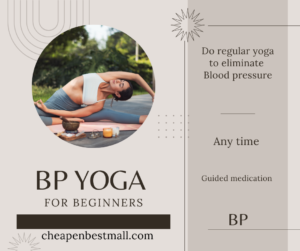Managing Blood Pressure: Yoga and Medication for Faster Care
High blood pressure (hypertension) is a significant health concern, often called a “silent killer” due to its lack of noticeable symptoms. Managing blood pressure effectively requires a combination of lifestyle changes, medications, and stress management techniques. Yoga and prescribed pills are powerful tools that, when combined, can accelerate recovery and improve overall cardiovascular health.
### **Yoga for Blood Pressure Control**
Yoga is a holistic practice that integrates physical postures, breathing techniques, and meditation to reduce stress and improve bodily functions. For individuals with hypertension, it helps lower blood pressure by promoting relaxation and enhancing heart health. Here are some specific yoga practices:
1. **Asanas (Postures):**
– **Shavasana (Corpse Pose):** Helps relax the body and reduce stress.
– **Balasana (Child’s Pose):** Encourages relaxation and reduces tension in the back and neck.
– **Viparita Karani (Legs-Up-The-Wall Pose):** Improves blood circulation and calms the nervous system.
2. **Pranayama (Breathing Techniques):**
– **Nadi Shodhana (Alternate Nostril Breathing):** Balances the autonomic nervous system, reducing blood pressure.
– **Bhramari (Bee Breathing):** Creates vibrations that calm the mind and decrease heart rate.
3. **Meditation:**
Practicing mindfulness and meditation helps reduce stress hormones like cortisol, a common contributor to high blood pressure. Even 10 minutes daily can make a noticeable difference.

When managing blood pressure, certain foods should be avoided or limited to maintain optimal cardiovascular health. These foods can contribute to high blood pressure, inflammation, and other heart-related issues. Here are some foods that should generally be avoided for better blood pressure control:
1. **Salty Foods**: High sodium intake is a leading cause of elevated blood pressure. Foods like processed snacks (chips, pretzels), canned soups, deli meats, and fast food contain excessive salt. It’s important to read food labels and avoid foods high in sodium, as they can cause the body to retain water, leading to higher blood pressure.
2. **Fried and Fatty Foods**: Deep-fried foods, fast food, and those rich in unhealthy fats (like trans fats) can contribute to weight gain and an increased risk of high blood pressure. Foods like fried chicken, doughnuts, and French fries can also raise cholesterol levels, which negatively affects blood pressure.
3. **Sugary Beverages**: Sugary drinks, including sodas, sweetened coffees, and energy drinks, can lead to weight gain and insulin resistance, both of which can exacerbate high blood pressure. They also cause spikes in blood sugar that can strain the cardiovascular system.
4. **Alcohol**: Excessive alcohol intake can raise blood pressure. While moderate drinking may not significantly impact blood pressure for everyone, regular heavy drinking can lead to long-term hypertension. It’s advised to limit alcohol consumption to one drink per day for women and two for men.
5. **Caffeine**: Though its effects vary from person to person, caffeine in large amounts can temporarily raise blood pressure. High-caffeine drinks, such as coffee, energy drinks, and some sodas, should be consumed in moderation or avoided if you are sensitive to caffeine.
Making mindful food choices and reducing the consumption of these items can go a long way in maintaining healthy blood pressure levels.
Role of Pills in Managing Blood Pressure
While yoga aids in long-term management, medications prescribed by healthcare professionals are crucial for immediate control. Blood pressure pills work in various ways:
1. **Diuretics:** Help eliminate excess sodium and water, reducing blood volume and pressure.
2. **Beta-blockers:** Decrease the heart rate and the force of heart contractions.
3. **ACE Inhibitors and ARBs:** Relax blood vessels by blocking hormones that cause vasoconstriction.
4. **Calcium Channel Blockers:** Prevent calcium from entering the heart and vessel cells, allowing smoother blood flow.
Combining Yoga and Medication for Faster Results
1. **Complementary Approach:** Medications address immediate symptoms and prevent complications, while yoga promotes long-term wellness and resilience against stress.
2. **Enhanced Adherence:** Incorporating yoga into a daily routine fosters a sense of well-being, encouraging better compliance with prescribed treatment plans.
3. **Regular Monitoring:** It’s essential to regularly check blood pressure levels to assess the effectiveness of the combined approach and adjust treatments accordingly.
### **Tips for Effective Care:**
– **Diet:** Pair yoga and pills with a balanced diet rich in fruits, vegetables, whole grains, and low-sodium options.
– **Exercise:** Include moderate physical activity, such as walking or swimming.
– **Lifestyle:** Avoid smoking, limit alcohol consumption, and maintain a healthy weight.
– **Consistency:** Practice yoga daily and adhere to your medication schedule as prescribed.
### **Conclusion**
Combining yoga and medication offers a comprehensive approach to managing high blood pressure. Yoga enhances the body’s natural ability to relax and heal, while pills provide the necessary medical support. Together, they create a synergistic effect that promotes faster recovery, reduced stress, and long-term health. Consult with your healthcare provider before starting any new regimen to ensure safety and effectiveness.

John DoeI heared here good knowledge and some yoga to cure my bp. Read More
Lorem ipsum dolor sit amet, consectetur adipiscing elit. Ut elit tellus, luctus nec ullamcorper mattis, pulvinar dapibus leo.

John Doe@username Read More
Lorem ipsum dolor sit amet, consectetur adipiscing elit. Ut elit tellus, luctus nec ullamcorper mattis, pulvinar dapibus leo.

John Doe@username Read More
Lorem ipsum dolor sit amet, consectetur adipiscing elit. Ut elit tellus, luctus nec ullamcorper mattis, pulvinar dapibus leo.
Previous
Next
Info
